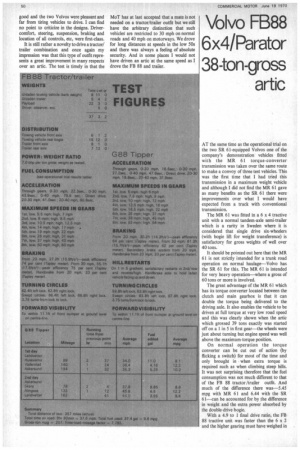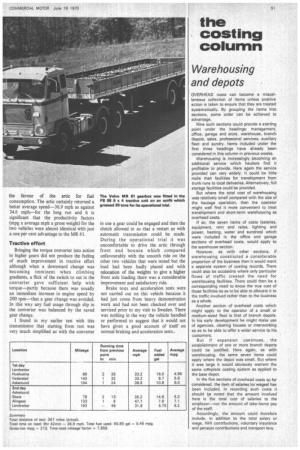Volvo FB88 6x4/Parator 38-ton-gross artic
Page 50

Page 51

If you've noticed an error in this article please click here to report it so we can fix it.
AT the same time as the operational trial on the two SR 61-equipped Volvos one of the company's demonstration vehicles fitted with the MR 61 torque-converter transmission was taken over the same route to make a convoy of three test vehicles. This was the first time that I had tried this transmission in a maximum weight vehicle and although I did not find the MR 61 gave as many benefits as the SR 61 there were improvements over what I would have expected from a truck with conventional transmission.
The MR 61 was fitted in a 6 x 4 tractive unit with a normal tandem-axle semi-trailer which is a rarity in Sweden where it is considered that single drive six-wheelers (with bogie lift for weight transference) is satisfactory for gross weights of well over 40 tons.
It should be pointed out here that the MR 61 is not strictly intended for a trunk road operation on normal haulage-Volvo has the SR 61 for this. The MR 61 is intended for very heavy operation-where a gross of 60 tons or more is involved.
The great advantage of the MR 61 which has its torque converter located between the clutch and main gearbox is that it can double the torque being delivered to the driving axle. It also enables the vehicle to be driven at full torque at very low road speed and this was clearly shown when the artic which grossed 39 tons exactly was started off on a I in 5 in first gear-the wheels were just about turning but engine speed was well above the maximum-torque position.
On normal operation the torque converter can be cut out of action (by flicking a switch) for most of the time and only brought in when extra torque is required such as when climbing steep hills. It was not surprising therefore that the fuel consumption was not much different to that of the FB 88 tractor/trailer outfit. And much of the difference there was-5.45 mpg with MR 61 and 6.44 with the SR 6 1-can be accounted for by the difference in weight and the extra power absorbed by the double-drive bogie.
With a 4.9 to I final drive ratio, the FB 88 tractive unit was faster than the 6 x 2 and the higher gearing must have weighed in
the favour of the artic for fuel consumption. The artic certainly returned a better average speed-36.9 mph as against 34.6 mph—for the long run and it is significant that the productivity factors (mpg x average mph x gross weight) for the two vehicles were almost identical with just a one per cent advantage to the MR 61.
Tractive effort
Bringing the torque converter into action in higher gears did not produce the feeling of much improvement in tractive effort although when a downward change was becoming imminent when climbing gradients, a flick of the switch to cut in the converter gave sufficient help with torque—partly because there was usually an immediate increase in engine speed by 200 rpm—that a gear change was avoided. In this way any fuel usage through slip in the converter was balanced by the saved gear change.
I found in my earlier test with this transmission that starting from rest was very much simplified as with the converter
in use a gear could be engaged and then the clutch allowed in so that a restart as with automatic transmission could be made. During the operational trial it was uncomfortable to drive the artic through front end bounce which compared unfavourably with the smooth ride on the other two vehicles that were tested but the load had been badly placed and with relocation of the weights to give a higher front axle loading there was a considerable improvement and satisfactory ride.
Brake tests and acceleration tests were not carried out on this vehicle because it had just come from heavy demonstration work and had not been checked over and serviced prior to my visit to Sweden. There was nothing in the way the vehicle handled or performed to suggest that it would not have given a good account of itself on normal braking and acceleration tests..


























































































































